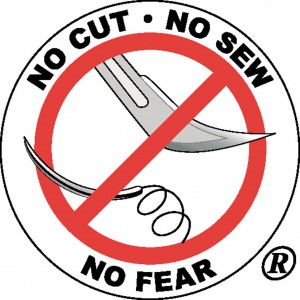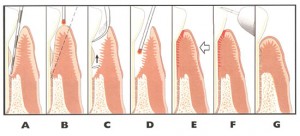Procedures and Portfolio
DENTAL IMPLANTS – Single, Multiple, Immediate Loading
| BEFORE | AFTER |
 |
|
| Aesthetics begin with conceptualizing the final implant restoration existing in harmony with the rest of dentition – Tarnow 1996 | |
 More and more older people are selecting dental implants over dentures as a replacement option for lost teeth. Whether you have lost one or all of your teeth, dental implants allow you to have teeth that look and feel just like your own.
More and more older people are selecting dental implants over dentures as a replacement option for lost teeth. Whether you have lost one or all of your teeth, dental implants allow you to have teeth that look and feel just like your own.
Older adults have a similar success rate with implants compared with younger people. As long as you’re in good health and your periodontist can restore healthy gums and adequate bone to support the implant, you’re never too old to receive a dental implant.
IMMEDIATE LOADING
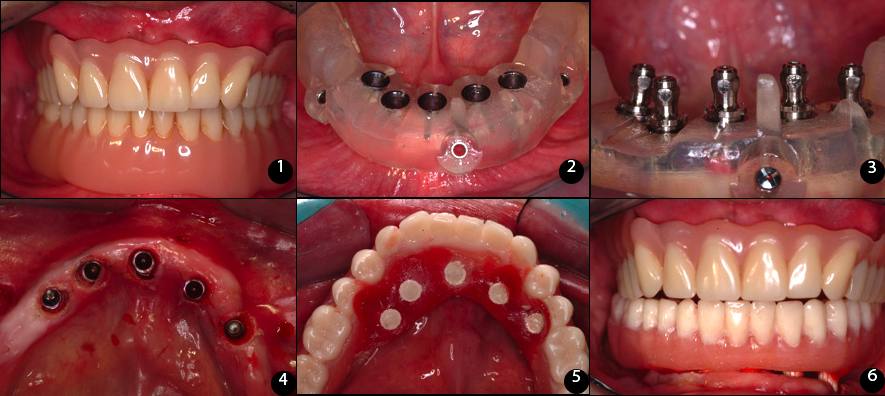 |
ASK FOR A SMILE CONSULTATION
Don’t we all want the best smile that we can have? Your periodontist or general dentist is just one phone call away. Set an appointment now for smile consultation.
You can ask anything and everything. Ask him/her all the esthetic concerns that you have in mind, like the”gummy-look” you may have, or the amount of tooth your smile should be showing, the color of your teeth among others.
You will be properly evaluated, and all the treatment procedures that will suit your personal needs, will be laid down and explained to you.
ENHANCING YOUR SMILES THROUGH PERIODONTAL COSMETIC PROCEDURES
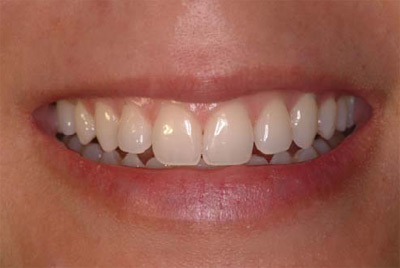 |
Is your smile very different from the picture above? You know you can also aspire for such a beautiful smile!
Are you not totally satisfied with your smile? There are actually a number of cosmetic periodontal and dental procedures that you can avail of to get a much improved smile that you can only dream of.
Current trends in periodontics will provide the solution to your dental concerns, whether you have a “gummy smile”, or have teeth that are too long as compared to your other teeth. On the other hand, a dental implant may be installed to replace your missing tooth/teeth.
GUMMY SMILE/UNEVEN GUMLINE
| BEFORE | AFTER |
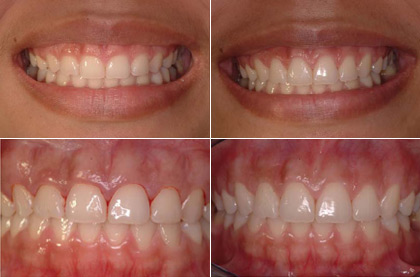 |
|
Teeth that are too short that shows too much gum can be transformed into a beautiful elegant smile. These teeth are not actually short. Your gums just fail to show the correct length and size of your teeth. Thus, it hides your smile. Crown lengthening procedures sculpts these excessive gums and leave you showing more of your teeth permanently.
This can also be combined with restorative procedures if you will have veneers or crowns to give you a real beautiful smile.
Maybe now is the time to consult your dental professional.This could be the first step to achieving the best smile that you want.
LONG TEETH/EXPOSED ROOTS
| BEFORE | AFTER |
 |
|
Do you have teeth that appear too long? This can be very unsightly because it exposes the root portion of your teeth. Worry no more because there are special periodontal treatments that can cover the exposed roots.
Receeding gums is the main cause of tooth root exposure. Gum recession is actually physiologic- we all experience a certain degree as we age. It proceeds at a very slow rate so it only becomes alarming if it progresses at a faster pace than the usual. On the other hand, recession may also result from periodontal disease. Whatever the cause, exposed roots are very unattractive and can become prone to root caries.
Soft tissue grafting is just one of the several root coverage procedures that can be done to remedy this problem.
MISSING TEETH/DENTAL IMPLANTS
| BEFORE | AFTER |
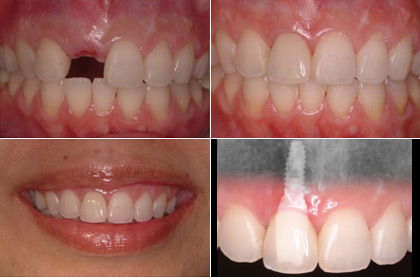 |
|
Missing one or more teeth affects one’s confidence and makes one hesitant to smile.
Dental implants are designed to replace missing teeth. The feel and appearance is very much the same as your natural teeth. This is a very highly recommended mode of restoration, because adjacent teeth do have to be ground down or damaged (which is routinely done) in the fabrication of bridgework. With dental implants, the adjacent teeth are left untouched. Implants can be placed in the front and the back portions of your mouth. It is very essential to have accurate placement and professional case management to achieve a real beautiful smile that give you confidence. This is why you have to be assessed bya highly qualified periodontist to find out if you are a good candidate for an implant or not.
A beautiful and confident smile through a well done dental implant is within your reach.
GINGIVAL SHAPING
| BEFORE | AFTER |
 |
|
We can give you a smile that you can never be ashamed of. If gummy smile persists, we can give you a totally new smile without adding anything. We just reshape and sculp your gums with no invasive procedures, done micro surgically!!! Let us give you the confidence you need in no time!
GINGIVAL OVERGROWTH
| BEFORE | AFTER |
 |
|
Unknown to many, when you are taking systemic medications, some of the side effects of this is your gums grow at a much faster rate. It causes problems such as bleeding gums, swelling gums and pain. Here we can help you eliminate the problem with simple gum recontouring. Visit us to have a good assessment of your case.
INDENTATIONS OF THE GUM AND JAWBONE
| BEFORE | AFTER |
 |
|
Indentation (or depression) in your gums and jawbone occurs usually after you lose one or more teeth.It happens because of bone recession on the areas where the tooth/teeth used to be.Aside from being unnatural looking, this indentation may affect the appearance of the replacement tooth.There is a tendency for it to look long if you compare it to the adjacent teeth.This “defect” can be filled up by your periodontist through ridge augmentation procedures.In effect, the natural contours of your jaws and gums will be restored making it easier to fabricate a natural-looking replacement restoration.This can also be prevented by RIDGE PRESERVATION procedures at the time of extraction.Bone graft materials are inserted into the socket to prevent any ridge collapse that occurs once a tooth is extracted.The preserved ridge will serve as a good bed for either implant placement or bridge fabrication.
NON SURGICAL: PERIODONTAL DEEP SCALING AND ROOT PLANING

Periodontal deep scaling and root planing (closed cleaning)is a non-surgical phase in periodontal treatment. This procedure entails removal of unexposed plaque and calcular deposit hidden beneath the gumline under local anesthesia. A thorough and complete root planing is done after scaling to ensure a smooth, plaque-free tooth surfaces. This procedure aids in the faster recuperation of the gums to return to its normal, healthy state again.
Oral rinses with antimicrobial function are often prescribed as home care maintenance to prevent further bacterial growth inside the oral cavity.
In some cases that pockets are very deep, due to limited access of the procedure, an open cleaning (periodontal surgery) may be recommended to restore periodontal health.
LASER PERIODONTAL THERAPY (LANAP)
BEFORE AFTER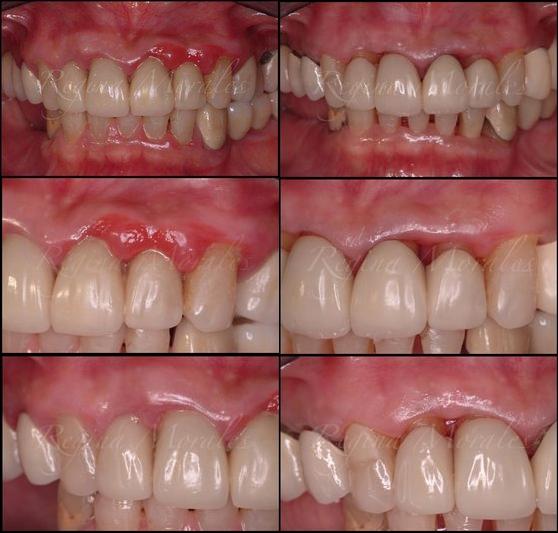
The newest technology for periodontal patient care is now available at the Asian Periodontics and Implant Dentistry Center. After an extensive training in the United States, Dr. Regina Santos-Morales has now acquired the latest in the world of periodontal treatment – the LANAP using Periolase MV-7. We are proud to say that we are the FIRST in Asia to provide this state of the art periodontal treatment.
The Millennium Dental PerioLase® was developed specifically to treat periodontal disease using LANAP (Laser Assisted New Attachment Procedure). This patented and FDA-approved laser therapy allows us to treat periodontal patients with a minimally invasive, breakthrough procedure, which in many cases eliminates the need for conventional blade and suture surgery, thus being tagged as the non-surgical alternative to traditional periodontal surgery.
The Laser Procedure includes the PerioLase®’s fiber optic tip removing diseased tissue and killing bacteria in the periodontal pockets while leaving healthy tissue relatively untouched. Ultrasonic scalers and/or hand instruments are then employed to remove calcular deposits that were loosened by the laser’s first pass. A second pass is made with the laser using a different setting to kill bacteria in the bottom of the pockets and on the bone, as well as stimulate the formation of a sticky fibrin clot. This clot seals off the pockets, allowing bone and other soft tissue and ideal environment for regeneration.
It can now be used effectively to reach down into the gum pockets to help eliminate inflamed tissue and destroy pathogenic bacteria with much less pain, bleeding, swelling and downtime after treatment. Therefore, for patients who are concerned about traditional cut and suture surgery to treat periodontal disease, the new laser treatment can be a life-changing event!
Laser Gum Treatment (LANAP) 3D Animation
LANAP Gum Treatment Testimonials
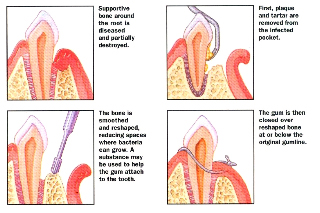
Periodontal surgery is commonly done on patient who has gum disease.After local anesthesia is administered on the surgical site, incisions are made to expose the surfaces of the teeth. The gums are then slightly pulled back to provide more access on the complete removal of sub-gingival plaque, calcular deposits and bacteria. Rough bony surfaces are smoothened out and gums are placed back together by resorbable stitches. Aperiodontal dressing is then placed above the gums to keep the area free from food impaction and irritation. After 7 days, the patient is seen for a post-operative check-up for the removal of the gum dressing and the remaining stitches. Evaluation of healing is also done at the same appointment…
CROWN LENGTHENING

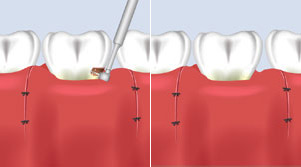
Crown lengthening is required when your tooth needs a new crown or other restoration and the edge of that restoration is deep below the gum tissue and not accessible.
It is important for you to be able to clean the area where the new restoration meets your existing tooth.
The procedure involves adjusting the levels of the gum tissue and bone around the tooth in question, to create a new gum-to-tooth-to-bone relationship.
This allows your restorative dentist assess to the edge of the restoration to ensure a proper fit to the tooth, and to provide enough tooth structure so the new restoration will not come loose in the future.
It also allows you access to clean the edge of the restoration of the restoration when you brush and floss, in order to prevent decay or gum disease.
After the procedure is finished, sutures and occasionally a protective “bandage” are placed to help secure the new gum to tooth relationship.
You will need to be seen in one week to remove the suture sand evaluate healing.
After the area has had a chance to heal, your restorative dentist will begin the process of placing your permanent replacement tooth.
FRENECTOMY
| BEFORE | AFTER |
 |
|
Labial frenum is a little fold of tissue or muscle that is found between the upper front teeth that attaches the lips to the gums. In cases that the attachment is too high, it causes spacing or diastema of the front teeth.
Frenectomy is done to correct the muscle attachment by removing a part of the tissue and reposition it to its ideal anatomical position.
Frenum attachment can also be found on the lingual area where it connects the tongue and the gums on lower front teeth. In abnormal cases that the frenum is too large, it limits the tongue movement and interferes with speech.
A frenectomy may take several weeks to heal completely. The patient to ensure faster healing process should practice proper oral care maintenance.
SURGICAL REMOVAL OF IMPACTED TEETH
Impacted tooth refers to a tooth that has failed to erupt fully to its expected position. Failure to erupt fully may be because of the following:
- Lack of space in the jaw to accommodate the erupting tooth
- Improper angulation of the erupting tooth
- Another tooth is blocking its eruption path
 |
If left untreated, an impacted tooth can lead to an infection of the gum tissue surrounding the tooth. This is called pericoronitis.
Impacted teeth can also get cavities. An impacted tooth can push on the neighboring molar leading to tooth movement and crowding, decay or gum disease. Rarely, impacted teeth can cause cysts or other growths in the jaw.
 |
The most important thing to know about impacted teeth is that they almost always require extraction with a qualified specialist, an oral surgeon. Surgical removal may be done under local anesthesia or under intravenous sedation, the latter being administered by a licensed anesthesiologist that we have in our center.


